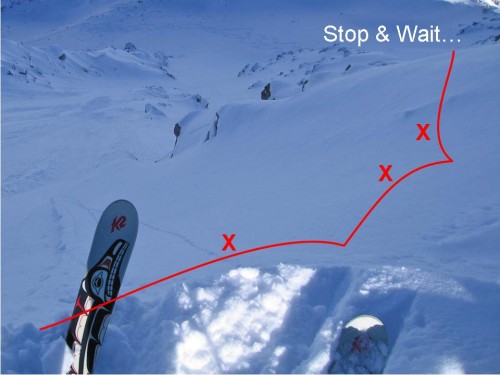Ski Cutting
Along with cornice stomping, I also do a lot of ski cuts before skiing a slope. Ski cuts are quite a bit dicier than cornice stomping as you have to actually get down on the slope and try to trigger a slide. Because of this, I am usually fairly confident that a slope won’t slide before I give it a ski cut, but do so anyways as a matter of habit. You never know.
If there is no “island of safety” to ski to, it might be better to find another slope rather than ski cut your way into the middle of an exposed slope and stop. Another critical element of ski cuts is to do them as aggressively as possible, like, really down-weight on the slope as you move over it. This is akin to bounce testing aid-climbing gear where the idea is to load it up as hard as possible so that if it is going to blow, you want it to go when you are expecting it, not as a surprise later on.
In the photo below, the “X” marks show where I’d really bounce on the slope. Notice on this slope I’d lose quite a bit of vertical with this ski cut (probably 100′ vertical feet), but it is important to both keep your speed up AND bounce as hard as possible, which means you are going to blow some vert in the process. The ridge at the end of the red line would form a so-so island of safe – not bad, but not great either. I’d prefer a cliff or rock to hide under.
Stopping and waiting for a few seconds after a ski cut is a good idea as sometimes slopes are slow to wake up and react. On a couple of occasions, I’ve cut a slope and when nothing happened, I rolled my first turn into the end of the cut, only to find that I’ve turned directly into a late blooming fracture. When this happens, you are heading the wrong direction and have lost your island of safety. Not so good.
________________________________
Help support StraightChuter.com and float like a butterfly then cut like a bee with K2 WayBack Skis from Backcountry.com. Click on the photo below…
Category: 07 Avalanche Avoidance











Ever ski cut on belay? Seems like if you’re that unsure about stability you shouldn’t be thinking about skiing the slope, but I guess I’m thinking about traverses where there are certain passes you have to descend on your objective. This might be a good technique (belayed ski cutting) in thoes situations…any thoughts?
Thanks man…
It is also important to have a steep enough angle so that if the slope fractures you have some momentum to help carry you to the safe zone.
Hi Morgan – good point. Speed is important as you need to be moving faster than any slab you happen to be on, otherwise you have no ability to turn off of it. If you are going 15mph and suddenly you are on a slab that is going 20mph, it doesn’t matter what you do as far as turning, etc., because you have no speed over the ground at that point, because the ground is moving.
Good idea – coming right up.
Thanks Andrew, the ski-cutting thing is not often talked about and is completely omitted from mainstream ski-media/movies and thus missing from the minds of most youth.
One of it’s conundrums I find is that many times ski cutting efforts are too timid to be effective. Although a good slice across the sweetspot can trigger a weakness, actual stomping is a better slope test, be it roped or free and especially in narrow scenarios where there is no escape to the side anyways and no way around a trigger zone.
Also I think it would be important to add that ski cutting is not exclusively for the top of the slope as fractures can propogate from features (relatively) anywhere on a slope. Thus also the importance of awareness of windspeed with regard to downslope loading into ones analysis on approaching the various features of the line. The higher the wind was, the lower down the slope is the critical loading.
I always admired Eric Pehota for his strategic style of skiing, actually cutting and positioning himself fluidly for any contingency the whole way down.
Then of course we could get into humorous commentary on size of turns, general skiing speed and ski width with regards to safety ;-) because even after ski cutting and the first couple of turns, one should have an emergency plan if there is a fracture above.
Thanks a lot for a post of this kind Andrew.
I am trying to use this technique more this season, so I can get “comfortable” with it – cutting smaller slopes or low consequences features. I never used it much before as I didn’t really know the proper way (more experienced way), so I was scared.
Ptor, thanks for your add ons. That is always what I thought about that lots of people ski cut at the top then if nothing goes they ski down without thinking anymore. Now someone of your caliber confirmed to me that this technique can be used lower down too. But I would imagine the possible consequences are bigger as now you have lots of slope above you :)
Thanks, I am moving on to read the belayed ski cutting article now.
BTW, Greg Hill and his crew use this technique a lot but I never had a chance to really observe it…or I never asked enough ;)
Hi Ptor – Thanks for the excellent comments. One of the most gut-wrenching ski cuts I’ve ever seen done was at La Grave one day when there was some serious avalanche potential. They (the lift company?) asked one of the local guides (Xavier) to go up and ski cut the huge cirque above the Trefide (spelling? sorry) and from below all you could see was one tiny little figure in the midst of a massive slope. Gulp! Nothing moved, so they opened it up.
Yeah Andrew, they still do that every day it snows! Funny (or maybe not so funny) the other day the guides were going up to do their “commision” and decide on opening the lift when a massive avalanche came down while they were still on the lift. All we could see at the bottom waiting for the lift to open was a giant avalanche cloud that gave us a couple extra centimeters at the bottom. the guides took the lift back down to midstation where all the slopes went sympathetic as they stepped onto the snow. they took the lift all the way back down.
I had to do alot of ski cutting while doing the Avalanche Control in Gulmarg. Very interesting stuff but not something restricted to professional use.
I’d like to see some kind of pride instilling educational media on the responsibilities of skiing first in a group instead of the very particular situations of freeride filmstars going for broke with the heli and guide ready to pick up the mangled bits. How do they become everybodys heroes/idols when they do everything with a guide?
Then there’s also the human bomb technique where you combine an airtime to add an extra load to your ski-cut. But you have to be feeling really confident for this one.